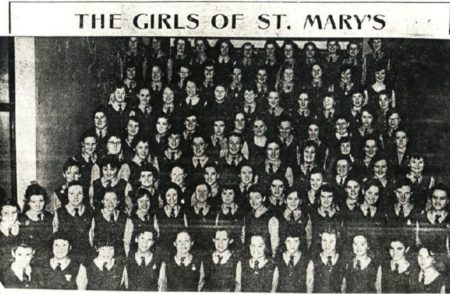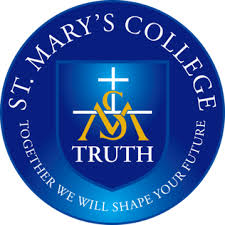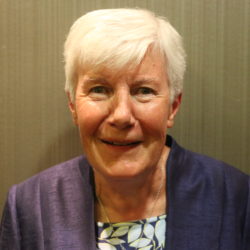 The first group of St. Mary’s students in 1959
The first group of St. Mary’s students in 1959
Exactly 60 years ago on September 8th 1959, the Sisters of Mercy opened St. Mary’s Secondary Intermediate School in Creggan. Back then, it was the largest Intermediate school in the North and Derry’s largest public building.
The history of St. Mary’s is rooted in the Mercy tradition. The first four Principals were Sisters of Mercy Sr. Emmanuel, Sr. Gertrude, Sr. Aloysius and Sr. Assumpta; all remarkable women in their own right. Many other nuns taught in the school over the years. Sr. Perpetua McNulty was the last nun to teach in St. Mary’s. As we celebrate our 60th anniversary, it is fitting that we acknowledge the enormous contribution the Sisters of Mercy have made, along with all the lay staff, to the education of thousands of young girls from all over the city through some of the most difficult times in the school’s history.

The late Sr. Emmanuel, first Principal of St. Mary’s Secondary Intermediate School described the mammoth task she and Sr. Aloysius McVeigh faced planning for the new school.
They worked out the layout of all 34 classrooms, drew up long lists of requisition for furniture and equipment for every single room. They planned a curriculum for the whole school and ordered books, stationery, charts and all the other educational aids. No clerical/support staff could be appointed until the school opened. Finally, and probably most challenging of all, they had to draw up a timetable for the 27 teachers and the 888 pupils aged 11 – 15 who arrived on September 14th.
Former Principal and Art Teacher, the late Sr. Aloysius has written about the fact that ‘the building was not quite ready for the pupils when it opened on September 8th and that the women of the nearby streets came with their mops, brushes and dusters and made sure the school was ready for pupils on the 14th September’.
Sr. Emmanuel has also written about the goodness of the people of Creggan at the time. ‘They rallied round us before the school opened to help with the cleaning. They often brought tea to the people working there before electricity and heating were installed’. The school opened without a front door and there was never an act of vandalism or theft. It was the people of Creggan who arranged a beautiful Scheme of Decorations, not only on the approaches to the school, but also in many other parts of the estate for the official opening on December 8th 2019.
At the official opening, Bishop Neil Farren apologised to the 500 girls who could not get a place in the new St. Mary’s and promised to build another Secondary Intermediate School for Girls. St. Cecilia’s Secondary Intermediate School opened in 1967.
During the Troubles, the school is described by past pupils and staff as an oasis of normality. Creggan was a ‘no-go’ area for the security forces and rioting was a daily occurrence. Bloody Sunday in January 1972 was undoubtedly St. Mary’s darkest hour when 13 civilians were shot dead by the Parachute Regiment of the British Army. Another man died months later from his injuries. The school officially closed for three days but remained open to provide sleeping accommodation for the hundreds of people who travelled from all over the world for the funerals in the adjacent St. Mary’s Chapel. The 13 coffins lined in front of the altar is a memory that is etched in the memories of everyone who was in Creggan at that time.
The British Army moved in to the “no-go” areas in July 1972 and army units occupied the school, using it as a base to patrol the area. During this difficult and dangerous time, St. Mary’s staff were the unsung heroes, providing security, stability and routine for the pupils.
Initially St. Mary’s, like all Secondary Intermediates, was not allowed to offer public examinations.
A few girls transferred to Thornhill at the end of first year. Most left at 15 to work in one of the local shirt factories or shops. A small number did the Junior Certificate at the end of 4th year and some went to the local Technical College to do secretarial courses.
Sr. Assumpta during her time at the helm contributed so much and it was Sr. Assumpta who introduced the school blazer at St. Mary’s.
In 1987, Dame Geraldine Keegan, a former Music teacher, was appointed as the first lay Principal. St. Mary’s entered a new era as there was numerous policy changes in education including the introduction of a Common Curriculum. Under Geraldine’s distinctive stewardship, performance in examinations improved significantly and St. Mary’s won numerous Quality Awards including Investors in People, Charter Marks and the EFQM Business Excellence Award both in 2001 and 2006. As a result, the school gained international recognition as a centre for educational and organisational excellence. In 1996 the Board of Governors approved the school name change to St. Mary’s College.
From it opened, the school was too small to cater for the number of girls attending and almost immediately ‘the extension’ arrived. Over time, more and more mobile classrooms were added. These temporary classrooms deteriorated rapidly and from the early 1990’s, St. Mary’s was in line for major refurbishment. Martin McGuinness was appointed Minister for Education in 1999 and before leaving his post in 2002, he announced a number of new builds including a new build for St. Mary’s College.

In 2010, after celebrating its Golden Anniversary, St. Mary’s moved to a beautiful new hi-tech campus at Northland Road. Taking St. Mary’s College out of Creggan was very difficult but the new school simply could not fit on the old school site. As well as moving to a new building, it was really important that the Mercy tradition and the strong sense of family that was so much part of St. Mary’s at Fanad Drive, was central to the ethos of the new school at Northland Road.
St. Mary’s College was recognised as a Specialist School for Science in 2006, a Microsoft Showcase School in 2013 and a Digital SchoolHouse in 2018. The College retains a very strong STEM focus today. All pupils study Science to 16 and most pupils choose at least one STEM subject post 16.
The School has an excellent reputation in the community and beyond. This is due in no small part to the excellent standards the pupils achieve in external examinations year on year and their success in a wide range of extra – curricular activities.
This year alone St. Mary’s was recognised as a Digital SchoolHouse and they also received the IIP Health and Wellbeing Award.
Maeve Stillman (Year 13) is UK Young Scientist of the Year, Ava Canney (Year 12) was runner up in her category at the BigBang and also won the Royal Society of Chemistry Award at the NI Young Innovators Competition –
Caoimhe O’Reilly was awarded the prestigious Protégé of Peace Scholarship to study at Lawrenceville High School in New Jersey and Catriona Walsh (Year 14) is a Young Reporter with the British Film Institute. The U16 Gaelic Team won the Foyle Shield and the U14s were runners up in the Foyle Plate.
The Innovative Entrepreneur in Residence Programme with Mr Lynch and local Entrepreneur and Angel Investor Mary McKenna is going from strength to strength as is the Swim Tri Academy in association with Triathlon Ireland.
Clearly the success story that is St. Mary’s is due in no small way to our wonderful pupils and the incredibly hard working staff, Governors, Chaplains, parents and the wider community who have played their part in making St. Mary’s the lovely success story that it is today.
We owe them all a great debt of gratitude. Looking back over the years, it is also important to be thankful for all those who worked so hard on behalf of the pupils, to ask forgiveness for any hurt caused and to be thankful for the many blessings we shared.
This article was first published in the Derry Journal


